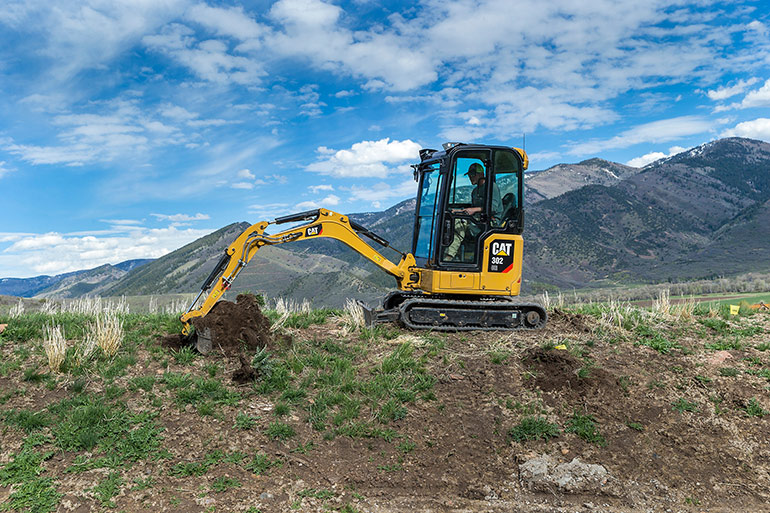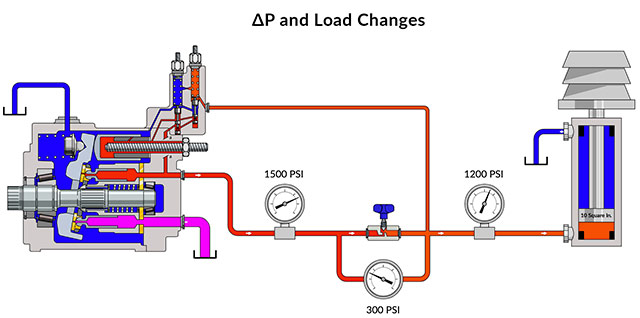The need for lower weight, size and costs mean that mobile machinery often sets the stage for power density improvements in fluid power.
All hydraulic machinery should be similar in scope and design, one would think. After all, the point of fluid power is to transmit force. Why should any given mobile machine be vastly different in its execution than any given industrial machine, for example? If we’re only transmitting force, can’t this be achieved with the same pumps, the same valves and the same actuators?
My question is naïve, of course. Machinery is different for many reasons, not the least of which are the preferences of the engineer(s) designing them. Mobile machinery works within broad environmental conditions and with specific design limitations, both of which are not handicaps for industrial machinery, which is freer to “be itself” as it were.

Image courtesy of Caterpillar
Mobile demands lower costs
The industrial hydraulic environment enjoys liberties not available to the mobile machinery camp. The most obvious of which are space and budget. Although not necessarily unlimited, hydraulic power units are bespoke designs naturally requiring individual attention for each build, so we understand the cost is often high. The same, too, with available real estate; both the power unit and actuators often have no dimensional limitations with floor or installation space. Mass, of course, is entirely irrelevant on industrial hydraulic machinery, as is evident if you’ve ever seen an automotive stamping press.
The mobile hydraulic machinery industry is a shallow-margin, competitive business with strict cost control, even though some individual machines may cost more than entire industrial manufacturing plants. High volume machinery, such as excavators, loaders and aerial lifts, etc. are manufactured in the thousands. Because dozens of companies make these machines in volume, the cost of every component from hex nut to closed-loop pump is at the low end for its segment.
It’s not to say manufacturers choose economy grade hydraulic components across the board, because some applications absolutely require highly engineered, robust and reliable pumps, valves and actuators. It’s that component suppliers live with slim profit margins as a penalty for being the supplier of choice for the application. If a skid steel loader manufacturer is shipping a thousand units a quarter, all using the same spin-on filter assembly, you can bet they’re paying a fraction of the retail price an end-user would.
However, industrial hydraulics do not operate in a cost-is-no-object environment, but the industrial customer prizes reliability, quietness and efficiency more often than does the mobile domain. So even if the closed-loop drive on a front-end loader uses the most advanced hydraulics on the planet, it doesn’t mean your logsplitter manufacturer is subject to the same requirements. The logsplitter is a mobile hydraulic example where cost is absolutely the most critical factor in the purchasing decision, so long as the part does its job.
Weight, size limitations
Mass is a paramount concern for most mobile machinery, and often concomitantly considered alongside cost. Counterintuitively, reduction in mass is more expensive, not less. The easy solution to machine design is to throw thick plates of steel everywhere you can to ensure your machine is strong enough to handle its functional purpose reliably. Compared to the alternative, steel is cheap.
The alternatives are expensive: advanced computer design with models and simulations, exotic and lightweight materials, and electrification to replace mechanical or hydraulic components. Weight reduced from the components of a machine can be added to maximum load capacity, especially if Gross Vehicle Weight regulations are part of the equation.
Consider power density and its relationship with hydraulic machines. Herein lies what is the primary differentiating factor in setting mobile hydraulics apart from its industrial cousin. Power density is why hydraulics remain relevant to mobile machinery. Power density is defined as the power output capacity as a ratio of actuator size. Nothing can touch the power density of hydraulic actuators, and it’s likely nothing ever will.
The wheel drive motors on a modern bulldozer, for example, operate at more than 6,000 psi – double the standard for industrial hydraulics. Imagine a 300 hp (220 kW) drive motor weighing only 260 lb (120 kg). If you think 260 lb seems like much mass, consider that a 300-hp, 1,800 rpm industrial electric motor weighs … 3,000 lbs (1,360 kg). Mind you, that same hydraulic motor exists for industrial hydraulic applications, like the screw motor on an injection molding machine. However, that screw motor is unlikely to run at greater than 6,000 psi.
While we’re on power density and hydraulic motors, I like to throw in a shameless plug whenever I can. If you think the above radial piston drive motor example is impressive, let me introduce you to bent-axis piston motors. This motor has a unique fixed swashplate angle and heavy-duty bearing combination that facilitates high speed operation at close to 6,000 psi, in many examples. The tiny Bosch Rexroth A2F5 motor (just 5 cc of displacement) spins dizzyingly to the tune of 35 hp (26 kW), weighing only 5.5 lb (2.5 kg) and fitting into your venti blonde espresso cup.
So, the power density of hydraulics frees up mass in mobile machinery, whether that mass supplants load carrying capacity or not. In this era, likely the mass reduction helps the machine meet strict emissions standards and to downside the power unit, which is, at times, the most expensive single purchase for the machine. Making do with less than 175 hp (130 Kw) when the earlier machine required 200 hp or more, means the diesel engine and all its cumbersome emissions-related components enjoy downsizing.
Controls are night and day
Where mobile and industrial hydraulics differ nearly without exception is on the control side. Both are regulated using entirely different components, circuits and logic. It starts with the basic through-center directional control valve used with fixed displacement pumps. Through-center is similar to a tandem center industrial valve, where pressure can flow from inlet to tank when the valve is unshifted in neutral.
Industrial tandem center valves are limited in their flow capacity because fluid travels through the spool itself in neutral with high pressure drop. Through-center valves have an entirely separate core, called the through-center core, in addition to the power core and tank core. The through-center core for a single spool valve simply exits to the tank. However, if you add a power beyond adapter, the through-center core separates from the tank core, and all fluid passes downstream when the valve is in neutral. This allows auxiliary downstream functions. Large, multi-spool sectional and monoblock valves also use this construction, but share passageways within their very construction, omitting the requirement for a power beyond adapter.
Industrial applications use mostly stacked valves or custom integrated manifold circuits. However, although mobile applications commonly use integrated circuits as well, advanced sectional valves with custom functionality are standard practice for heavy-duty machinery. They are optioned for either fixed or variable displacement pumps and come prepped with drillings and ports for accessory valves. Port relief or counterbalance valves are frequent additions, and if unused, you close off the passages with a cavity plug.

Load sensing is a control concept that is only used on mobile equipment. This schematic shows load sensing control on a piston pump simulation. Image courtesy of LunchBoxSessions.com
Click here to see the animation come to life at LunchBoxSessions.com.
A control tactic common in mobile hydraulics I’ve never seen in the industrial market is load sensing. Load sensing is a control concept that measures downstream pressure close to the actuator to compare load pressure and flow-induced pressure drop. This load sense signal feeds back to the pump, which interprets the signal and provides only enough flow and pressure to satisfy the demand of any currently operating valve. The load sense pressure drop is typically only a few hundred psi, providing efficient operation for applications using a diverse set of actuators.
I believe as technology advances, mobile and industrial hydraulic design trends will continue to evolve separately, but in parallel. Power density in mobile applications continues to rise, and efficiency placed at the forefront will ensure reduced carbon footprint and increased productivity.
Filed Under: Mobile Hydraulic Tips